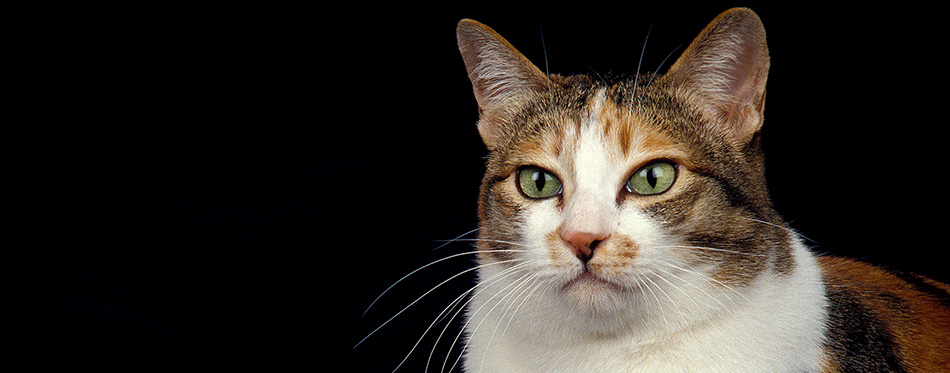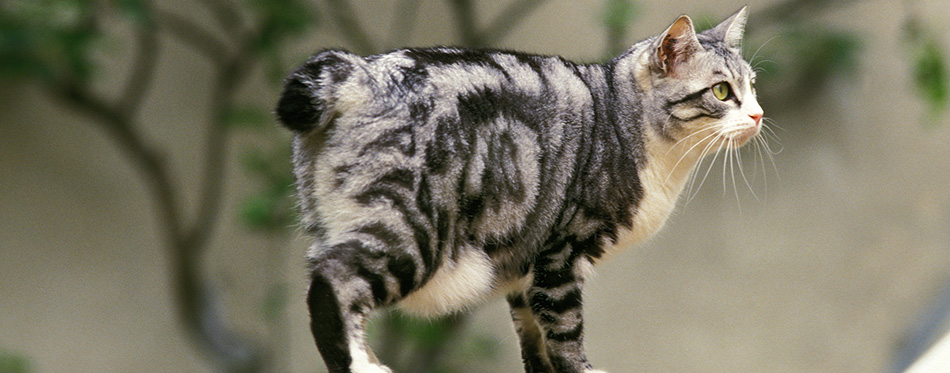The Japanese Bobtail is a breed of domestic cats with the most adorable but also quite unusual short and fluffy tail that more closely resembles the tail of a rabbit than a cat. It’s also one of the most loved and popular cats in Japan; so popular that it has become a symbol of good luck – Maneki Neko, the figurine cat with a raised paw that brings good fortune to its owner and visitors.
Believed to originate in the Far East, about 1,000 years ago, the Japanese Bobtail is one of the oldest domestic cat breeds in the world. Lively, affectionate and intelligent, the Bobtail comes in two varieties: longhair and shorthair. Both types come in almost any color as well as a number of patterns, but white calicoes are favored in Japan as they’re strongly represented in their folklore. That said, Bobtails of all colors and patterns are loved around the world.
If you’re considering getting a Japanese Bobtail, read on as we give you the lowdown on this beautiful, talkative and energetic kitty!

History of the Japanese Bobtail Cat
The Japanese Bobtail is believed to originate from the Far East, and although it’s strongly represented in the Japanese folklore, it doesn’t seem to have developed in Japan. Other regions of the Far East, including China, Malaysia, Thailand and Burma seem to be its places of birth. That said, written records and paintings document the existence of the breed in Japan for more than 1,000 years. In fact, there is a 15th-century painting in the Smithsonian Institute in Washington that depicts two longhaired Japanese Bobtails. There are also several drawings of the breed sitting next to geishas. Clearly, humans were obsessed with cats even before the Internet!
Besides the paintings and sketches, there are also various references to the Bobtail cats in Japanese folklore, including a legend of a feline whose tail caught fire while sleeping. Frightened, the cat reacted by running, accidentally setting fire to houses, trees and everything in the Imperial city. Because the entire town was burned to the ground, the Emperor passed a decree that the tails of all cats were to be chopped for future prevention.
Another highly popular tale is the legend of Maneki Neko, the beckoning cat. Centuries ago, there was a poor monk who lived in a small temple in Tokyo. Although he was poor and often didn’t have enough food for himself, he would always share his meal with his (bobtail) cat named Tama. One day, Lord Nakaota Li, on his way to hunt, was suddenly caught in a storm. To shelter himself from the rain, he hid under a big tree near the monk’s temple. There, he noticed the cat Tama with a raised paw, who looked like it was waiving him to the temple. Surprised and curious to see the cat, he left the tree and headed to the temple when a lightning bolt struck the tree, destroying it. As a sign of gratitude, Nakaota became the patron of the temple, repairing and renaming it Gotoku. When Tama the cat died, they buried him in a graveyard for cats and made a statue to commemorate him. And so, Maneki Neko, the beckoning cat that brings luck, was born.
Before the 17th century, Bobtails were revered, practically worshipped in Japan. Then, in 1602, Japanese authorities decreed that all cats should be set free to help with the rodent situation. Mice were destroying precious silkworm population on which the Japanese industry thrived upon, so to counter the menace, Bobtails were set loose. Left to live on farms and in the streets, Bobtails became the “street cats” of Japan, losing their previous symbol status.
But, in 1701, doctor Engelbert Kaempfer wrote in his Kaempfer’s Japan that “there is only one breed of cat that is kept. It has large patches of yellow, black and white fur; its short tail looks like it has been bent and broken. It has no mind to hunt for rats and mice but just wants to be carried and stroked by women.” Apparently, it didn’t take long for Bobtails to return to their revered status!
The Bobtail arrived in the USA in 1968, when the cat breeder Judy Crawford sent a few cats to Elizabeth Feret. When Crawford returned to the USA, she brought even more Bobtails with her, working with Feret to get the breed recognized. The shorthaired variety was first to be recognized for competition in 1979, and although the longhaired variety also existed for centuries, it was recognized for competition in 1991.
Quick Facts About the Japanese Bobtail Cat
- They’re highly active and affectionate
Bobtails are famous for their lively, always-ready-to-play personalities. They’re natural athletes, especially when it comes to jumping and prancing around, so they need daily physical activity. They’re also highly affectionate and attentive – in fact, if a Bobtail senses that their owner is distraught, they will offer companionship and their paw for comfort.
- They’re one of the oldest naturally occurring cat breeds
Written records reveal the Bobtails first arrived in Japan from China or Korea about 1,000 years ago. It is believed that the original domestic bobtails came with the Buddhist monks in 600-700 A.D. to keep the mice and rats out of the temples.
- They’re a healthy and strong breed
If you’re looking for a healthy, physically strong cat, the Japanese Bobtail is the pet for you. These resilient felines are some of the healthiest cats in the world – compared to other breeds, their kittens start being active earlier, walk earlier and are generally faster in their development. They also have a high disease resistance rate and some of the lowest kitten mortality rate.
- They’re very vocal
Bobtails are some of the most talkative cats. With their soft voice, capable of nearly a whole scale of tones, they love to “converse” with their owners. Whenever you speak to your Bobtail, expect them to speak back to you. Some people swear their Bobtails even sing!
- They’re highly attracted to water
While some cats hate water and hide on the mention of the word “bath”, the Japanese Bobtails actually love it. If there is a small body water around, expect your Bobtail to stick their nose in it, dunk their paws, perhaps even jump on/in it or roll around. Many owners find that their Bobtails dunk their toys in their water dish whenever they get the chance.
- They shed minimally
Despite having beautiful, soft coats, both shorthaired and longhaired Bobtails shed minimally. This is because they have very little undercoat, which means their coat length doesn’t mat. So, grooming is a piece of cake – brushing them once or twice a week is more than enough to keep their coat soft and silky.
Things You Should Know
Before buying or adopting a Japanese Bobtail, it’s good to know the basics about the breed’s health, feeding, care and grooming requirements, as well as their temperament. Knowing these facts will help you take great care of your cat and will ensure they’re healthy and happy for years to come.
Health
We mentioned that the Japanese Bobtail is one of the healthiest breeds in the world. They’re strong, resilient pets who, despite having a recessive gene and a shortened tail, do not have any spinal or bone abnormalities. That all being said, just like any other cat, the Bobtail can have various health problems related to its genetics. That’s why it’s important to always ask a breeder about the incidence of health issues in the cat’s line, as well as to check what testing has been done.
Feeding
Like all cats, Japanese Bobtails are obligate carnivores, so a diet high in quality-protein is a must. While all good-quality animal protein sources are great, including chicken, lamb, beef, and other, fish seems to be the animal of choice for many Bobtails. That said, you should diversify your pet’s diet as much as possible as feeding the same food will inevitably lead to boredom on your cat’s part. So, even if you find a particular food/brand that your Bobtail likes, it’s recommended you switch to a different formula from time to time.
Always make sure you’re feeding a diet appropriate for your cat’s life stage. Kittens should be fed kitten food, adult Bobtails food formulated for adults, and older cats can benefit from eating senior cat food. Also, if your Bobtail is a house cat, it’s a good idea to frequently feed a special diet, one that will prevent or reduce the formation of hairballs. Check out our guide on cat food for hairballs for more info.

Care and Grooming
Despite having soft, beautiful coat, the Japanese Bobtail doesn’t require complicated grooming sessions. Both the shorthaired and longhaired varieties have very little undercoat, so are easy to care for and groom. Brushing your Bobtail once to twice a week with a soft pet brush will keep their coat nice and neat and prevent tangles, which are uncommon for Bobtails anyway. When brushing your pet, make sure you handle the tail gently, especially if it’s more on the rigid side.
The Japanese Bobtail has a water-resistant coat, so bathing is rarely necessary. That said, if your outdoor Bobtail cat gets dirty or smelly and you feel like they could do with a wash, bathing them with a cat-specific shampoo is of course welcome. Luckily, they don’t fear water like other breeds, so are be easy to relatively easy to bathe, even though you do need to use some elbow grease to shampoo their water-resistant coat.
To keep your beautiful Bobtail healthy, you’ll also need to brush their teeth from time to time to prevent periodontal disease. If you can do it daily, that’s best, but if not, once a week is better than nothing. Also, clean their eyes every couple of days with a damp cloth to remove any discharge, and use a different cloth for each eye if the cat has an infection. Another thing to regularly clean is your cat’s ears. Use a damp, soft cloth to wipe out any dirt while checking for any strange lumps and bumps. Find out more about cat toothbrushes and cat shampoos here.
Like most other cats, Bobtails can be finicky when it comes to their bathroom habits. Keep their litter box clean by scooping it daily and washing it every time you change the litter. For more options, check out our detailed review of the best litter box for cats.
Temperament
The Bobtail is an intelligent, affectionate and energetic breed that remains this way until their old age. They’re also playful, which, coupled with their bright mind, means they’re easy to train. In fact, they’re incredibly easy to housebreak and do great with both people and other animals. They love toys, challenges and puzzles and are good at learning tricks, so they’re best suited for similar-minded folks – people who love spending time with their pets and teaching them new things. Take a look at our reviews of the best cat toys and interactive cat toys for more options.
The Bobtail is a wonderful companion – affectionate and attentive, it loves spending time with their owner, but is not overly needy. They’re quite sensitive too, and can “sense” when their owner doesn’t feel well. They’re known to offer their paw for comfort and will happily sit in the lap if the owner is up to it.
This breed is also highly creative, and sometimes not in the ways that their human family appreciates. If you don’t find ways to keep your Bobtail busy and entertained, they themselves will find a way to do so, sometimes by using your socks, paper money or toilet paper as their toys. For this reason, it’s important to keep your Bobtail occupied either with other animal(s) or toys when you’re not at home.
Sources:
- Japanese Bobtail – PetMD
- Japanese Bobtail – The Cat Fanciers’ Association

